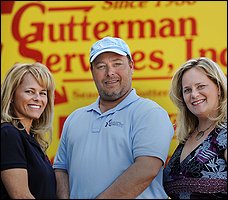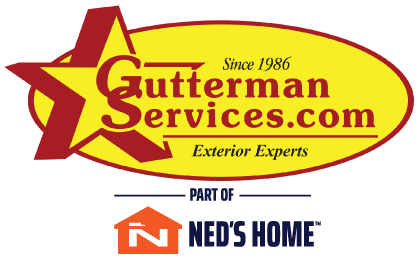Roof-and-gutter service finds the silver lining in Snowmageddon
Gutters | September 25, 2012![]() By Thomas Heath
By Thomas Heath
Monday, July 5, 2010
Part of running a business is knowing when opportunity hits and grabbing it. Better to be lucky than smart, right?
 Roofer-gutter repairman Chris Pauly saw the opportunity of a lifetime in February when the first reports emerged of a gigantic snowstorm approaching Washington. Pauly’s quick response to the storm, which became known as Snowmageddon, could be a case study in how to make the most of a weather disaster. As soon as the snow stopped and the sun came out, Pauly put up his 40-member staff in a hotel across the street from Sterling-based Gutterman Services, feeding them and working them 16 hours a day. Internet-savvy staffers immediately hit the road, videotaping clogged and icy gutters and snow-laden roofs. Every six to 10 hours, they posted the videos — which they called “weather alerts” — on YouTube and then sent the link to Pauly’s database of 1,000 clients. “We went viral,” Pauly said. “We knew it would be important to stay in touch with the client base and keep them up to date about ice situations. It was a step-by-step instruction on what to do when your house was leaking real bad.”
Roofer-gutter repairman Chris Pauly saw the opportunity of a lifetime in February when the first reports emerged of a gigantic snowstorm approaching Washington. Pauly’s quick response to the storm, which became known as Snowmageddon, could be a case study in how to make the most of a weather disaster. As soon as the snow stopped and the sun came out, Pauly put up his 40-member staff in a hotel across the street from Sterling-based Gutterman Services, feeding them and working them 16 hours a day. Internet-savvy staffers immediately hit the road, videotaping clogged and icy gutters and snow-laden roofs. Every six to 10 hours, they posted the videos — which they called “weather alerts” — on YouTube and then sent the link to Pauly’s database of 1,000 clients. “We went viral,” Pauly said. “We knew it would be important to stay in touch with the client base and keep them up to date about ice situations. It was a step-by-step instruction on what to do when your house was leaking real bad.”
He also did another smart thing about that time: He saved his money and bought a 14-acre parcel in Loudoun County for $50,000. The land, now worth about $400,000, is used as collateral for Pauly’s business loans.
He started calling himself the Gutterman because, as he told my colleague Dana Hedgpeth, who found Gutterman and did most of the reporting and writing for this column, “Little ladies would say, ‘Herb, the gutterman is on the phone’ when I called so I just started calling myself that.”
With 44 full-time employees and help from his two sisters in running the business, he has averaged about $4.5 million a year in sales over the years. He said he pays himself in the “low six figures.” He has about $300,000 in debt from buying equipment and trucks. A few years ago, he bought some land and built his own headquarters so he wouldn’t have to keep renting office space.
“We’d have sales meetings and we couldn’t fit everyone in the office, so we’d have to rent conference rooms at a nearby Holiday Inn,” he said.
When the recession hit, Pauly’s revenue dropped 22 percent, forcing him to cut salaries 20 percent. Before the recession, he was making a profit of 5 to 9 percent annually; these days it is more like 2 to 4 percent, he said.
“People don’t think about their gutters until they have to,” Pauly said. “Wouldn’t you have rather gone to, say, the Outer Banks for a couple of weeks than spend money on fixing your gutters? They’re just not a sexy problem, or at least not until you see them falling off.”
Last winter, his crews worked on more than 800 roofs, averaging at least 10 or more hours a day, to repair gutters and drains that broke under the weight of the heavy snows. A length of gutter can typically hold about 15 pounds, but a heavy snow can increase that burden to 50 pounds, causing it to crack and break. Then there are problems with “ice dams,” where snow melts, gets in the overhang of a roof, creeps under shingles and eventually leaks inside the walls.
Pauly said he does very little advertising; his business is all word-of-mouth. He has about 600 customers on yearly service contracts, which is the bread and butter of any service business. His competition comes from what he calls “two guys in a truck” who are unlicensed and promising home repairs. To combat that, he said he advises homeowners to go with him because he’s licensed and insured.
Pauly is a stickler for making sure that his employees do quality work and are safe when they’re up on roofs. His stepfather fell off a roof in the 1970s, seriously injuring himself.
“This is highly skilled, dangerous work,” Pauly said.
Pauly expects to make a profit of $300,000 on sales of $5 million, for a net profit margin of 6 percent. Most of that will be rolled back into the company as working capital.
His biggest expenses, on-site labor and material, use up 55 percent of revenue. Another big item is insurance, which runs more than $200,000 annually. Most of the rest goes to various other costs — for instance, 15 trucks, other equipment and nearly 20 white-collar employees, including sales staff.


